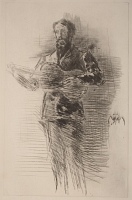Etchings Institutions search term: grolier club
The Guitar Player (M.W. Ridley) | ||
| Number: | 124 | |
| Date: | 1874/1875 | |
| Medium: | drypoint | |
| Size: | 279 x 179 mm | |
| Signed: | butterfly at right | |
| Inscribed: | no | |
| Set/Publication: | no | |
| No. of States: | 7 | |
| Known impressions: | 11 | |
| Catalogues: | K.140; M.138; W.122 | |
| Impressions taken from this plate (11) | ||
PUBLICATION
EXHIBITIONS

14: Memoir, [1886/1887?], GUW #08699. Marcus Bourne Huish (1843-1904) was Director of the Fine Art Society.
 ). 15
). 15
15: New York 1881 (cat. no. 141); see REFERENCES: EXHIBITIONS.
 ) to the exhibition organised by the Caxton Club in Chicago, and Bryan Lathrop (1844-1916) lent his as a second state (
) to the exhibition organised by the Caxton Club in Chicago, and Bryan Lathrop (1844-1916) lent his as a second state ( ) - in both cases the etchings were of a later state. 16 Impressions were shown at the Pennsylvania Academy of Fine Arts in 1902, lent by Howard Mansfield (1849-1938) (
) - in both cases the etchings were of a later state. 16 Impressions were shown at the Pennsylvania Academy of Fine Arts in 1902, lent by Howard Mansfield (1849-1938) ( ), and by H. Wunderlich & Co. in New York and Obach & Co. in London in 1903.
), and by H. Wunderlich & Co. in New York and Obach & Co. in London in 1903.16: Chicago 1900 (cat. nos. 110, 110a).
 ) and another lent by H.R.H. Princess Victoria to the London Memorial in 1905. 17
) and another lent by H.R.H. Princess Victoria to the London Memorial in 1905. 17
17: New York 1904a (cat. nos. 126a, b, c); Boston 1904 (cat. no. 92); London Mem. 1905 (cat. no. 122).
SALES & COLLECTORS
18: [March/April 1875], GUW #07573.
Guitar Player No. 3 ' ' 20
Guitar player - (P C) 21
19: To Marcus Bourne Huish (1843-1904), 10 October 1877, GUW #12734.
20: To C. A. Howell, 12 October-5 November [1877], GUW #12735.
21: To J. Hogarth, 22-27 October [1877], GUW #12737.
In 1877 Whistler sold several impressions at £10.10.0 each, to the Fine Art Society, London, Charles Augustus Howell (1840?-1890), the Royal Collection, Windsor Castle (
 ), and to another print firm, Messrs Hogarth. 23 Messrs Dowdeswell also bought some impressions from the Fine Art Society and exhibited them in their new gallery.
), and to another print firm, Messrs Hogarth. 23 Messrs Dowdeswell also bought some impressions from the Fine Art Society and exhibited them in their new gallery. Whistler later bought one back from Edmond Gosselin (1849-1917) on 9 May 1887 for 150fr. 24 It was offered by Whistler to the Glasgow art dealer William Craibe Angus (1830-1899) who queried the print: 'The Guitar Player. This impression has curious whitish lines running across the plate from under the arms to the feet - Kindly say if these lines are on all the impressions - .' 25 There is no record of Whistler's reply. However it is very likely that Craibe Angus kept the print because he had two local collectors who acquired impressions, Bernard Buchanan MacGeorge (1845?-1924) (
 ) - reproduced below - and Thomas Glen Arthur (1858-1907) (
) - reproduced below - and Thomas Glen Arthur (1858-1907) ( ).
).At the sale of the important collection of the late Joshua Hutchinson Hutchinson (ca 1829 - d.1891) in 1892 an impression was bought by Edmund F. Deprez (1851-1915) of Deprez & Gutekunst for £3.0.0 - clearly a lot less than Whistler was getting. 26
26: Sotheby’s, 3 March 1892 (lot 201).
 ); Francis Seymour Haden, Sr (1818-1910) (whose impression was sold through Wunderlich's to Charles Lang Freer (1856-1919) (
); Francis Seymour Haden, Sr (1818-1910) (whose impression was sold through Wunderlich's to Charles Lang Freer (1856-1919) ( ); Howard Mansfield (1849-1938) (
); Howard Mansfield (1849-1938) ( ); and Frederick Keppel (1845-1912) (who sold another impression to Freer, in 1889) (
); and Frederick Keppel (1845-1912) (who sold another impression to Freer, in 1889) ( ).
).

